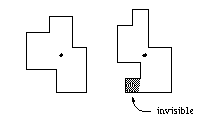poj 1474 Video Surveillance (半平面交)
链接:http://poj.org/problem?id=1474
| Time Limit: 1000MS | Memory Limit: 10000K | |
| Total Submissions: 3247 | Accepted: 1440 |
Description
The first problem is to choose where to install the camera for every floor. The only requirement is that every part of the room must be visible from there. In the following figure the left floor can be completely surveyed from the position indicated by a dot, while for the right floor, there is no such position, the given position failing to see the lower left part of the floor. 
Before trying to install the cameras, your friend first wants to know whether there is indeed a suitable position for them. He therefore asks you to write a program that, given a ground plan, de- termines whether there is a position from which the whole floor is visible. All floor ground plans form rectangular polygons, whose edges do not intersect each other and touch each other only at the corners.
Input
A zero value for n indicates the end of the input.
Output
Print a blank line after each test case.
Sample Input
4
0 0
0 1
1 1
1 0
8
0 0
0 2
1 2
1 1
2 1
2 2
3 2
3 0
0
Sample Output
Floor #1
Surveillance is possible. Floor #2
Surveillance is impossible.
Source
#include <stdio.h>
#include <math.h>
#include <string.h>
#include <stdlib.h>
#include <iostream>
#include <algorithm> #define eps 1e-8
#define MAXX 105
using namespace std;
typedef struct point
{
double x;
double y;
}point; point p[MAXX],s[MAXX]; bool dy(double x,double y){ return x>y+eps; }
bool xy(double x,double y){ return x<y-eps; }
bool dyd(double x,double y){ return x>y-eps; }
bool xyd(double x,double y){ return x<y+eps; }
bool dd(double x,double y){ return fabs(x-y)<eps; } double crossProduct(point a,point b,point c)
{
return (c.x-a.x)*(b.y-a.y)-(c.y-a.y)*(b.x-a.x);
}
point IntersectPoint(point u1,point u2,point v1,point v2)
{
point ans=u1;
double t=((u1.x-v1.x)*(v1.y-v2.y)-(u1.y-v1.y)*(v1.x-v2.x))/
((u1.x-u2.x)*(v1.y-v2.y)-(u1.y-u2.y)*(v1.x-v2.x));
ans.x+=(u2.x - u1.x)*t;
ans.y+=(u2.y - u1.y)*t;
return ans;
} void cut(point p[],point s[],int n,int &len)
{
point tp[MAXX];
p[n]=p[];
for(int i=; i<=n; i++)
{
tp[i] = p[i];
}
int cp=n,tc;
for(int i=; i<n; i++)
{
tc=;
for(int k=; k<cp; k++)
{
if(dyd(crossProduct(p[i],p[i+],tp[k]),0.0))//clock-wise
s[tc++]=tp[k];
if(xy(crossProduct(p[i],p[i+],tp[k])*
crossProduct(p[i],p[i+],tp[k+]),0.0))
s[tc++]=IntersectPoint(p[i],p[i+],tp[k],tp[k+]);
}
s[tc]=s[];
for(int k=; k<=tc; k++)
tp[k]=s[k];
cp=tc;
}
len=cp;
} int main()
{
int n,i,j;
int cas=;
while(scanf("%d",&n)!=EOF && n)
{
for(i= ;i<n; i++)
{
scanf("%lf%lf",&p[i].x,&p[i].y);
}
int len;
cut(p,s,n,len);
printf("Floor #%d\n",cas++);
if(len)
printf("Surveillance is possible.\n\n");
else printf("Surveillance is impossible.\n\n");
}
return ;
}
poj 1474 Video Surveillance (半平面交)的更多相关文章
- POJ 1474 Video Surveillance 半平面交/多边形核是否存在
http://poj.org/problem?id=1474 解法同POJ 1279 A一送一 缺点是还是O(n^2) ...nlogn的过几天补上... /********************* ...
- POJ 1474 Video Surveillance(半平面交)
题目链接 2Y,模版抄错了一点. #include <cstdio> #include <cstring> #include <string> #include & ...
- poj 1474 Video Surveillance - 求多边形有没有核
/* poj 1474 Video Surveillance - 求多边形有没有核 */ #include <stdio.h> #include<math.h> const d ...
- poj 1474 Video Surveillance 【半平面交】
半平面交求多边形的核,注意边是顺时针给出的 //卡精致死于是换(?)了一种求半平面交的方法-- #include<iostream> #include<cstdio> #inc ...
- ●poj 1474 Video Surveillance
题链: http://poj.org/problem?id=1474 题解: 计算几何,半平面交 半平面交裸题,快要恶心死我啦... (了无数次之后,一怒之下把onleft改为onright,然后还加 ...
- POJ1474 Video Surveillance(半平面交)
求多边形核的存在性,过了这题但是过不了另一题的,不知道是模板的问题还是什么,但是这个模板还是可以过绝大部分的题的... #pragma warning(disable:4996) #include & ...
- poj1474Video Surveillance(半平面交)
链接 半平面交的模板题,判断有没有核.: 注意一下最后的核可能为一条线,面积也是为0的,但却是有的. #include<iostream> #include <stdio.h> ...
- 2018.07.03 POJ 1279Art Gallery(半平面交)
Art Gallery Time Limit: 1000MS Memory Limit: 10000K Description The art galleries of the new and ver ...
- POJ 3335 Rotating Scoreboard 半平面交求核
LINK 题意:给出一个多边形,求是否存在核. 思路:比较裸的题,要注意的是求系数和交点时的x和y坐标不要搞混...判断核的顶点数是否大于1就行了 /** @Date : 2017-07-20 19: ...
随机推荐
- android自定义view属性
第一种 /MainActivity/res/values/attrs.xml <?xml version="1.0" encoding="utf-8"?& ...
- Ubuntu 13.10 64位 无法 安装 ia32-libs 解决办法
安装新立德软件包管理器:打开终端,输入以下命令:sudo apt-get install synaptic 打开新立德软件包管理器,选择“设置>软件库” 选择“其他软件 > 添加” 在AP ...
- python使用装饰器捕获异常
可以编写一个通用的捕获异常的装饰器, 当程序发生异常时可以继续执行后续动作. 尤其适合于使用大量断言的验证性程序. 装饰器的实现原理使用了回调技术. 如下所示, robust 是一个装饰器. 当在普通 ...
- Java编译那些事儿【转】
转自:http://blog.csdn.net/lincyang/article/details/8553481 版权声明:本文为博主原创文章,未经博主允许不得转载. 目录(?)[-] 命令行编译 使 ...
- c++ 程序在内存中的分布
从低地址到高地址: 1.代码区[包含常量的]:存放函数体的二进制代码 2.全局变量区[已初始化 + 未初始化]: 全局变量和静态变量的存储是放一块的,初始化的全局变量和静态变量在一块区域, 未初始化的 ...
- Hibernate,JPA注解@Embeddable
JPA嵌入式对象(又名组件) 在实体中可以定义一个嵌入式组件(embedded component), 甚至覆盖该实体中原有的列映射. 组件类必须在类一级定义@Embeddable注解. 在特定的实体 ...
- webservice cxf error:java.lang.IllegalArgumentException: Argument(s) "type" can't be null.
客户端请求DTO和服务器端的DTO定义不一样,客户端必须定义@XmlAccessorType和@XmlType,如: @XmlAccessorType(XmlAccessType.FIELD) @Xm ...
- Python编程核心之makeTextFile.py和readTextFile.py
引言: 最近大半年都在学习python编程,在双十一的时候购买了<Python编程核心>,看到makeTextFile.py和readTextFile.py两个例子有点错误,所以在这里给修 ...
- poj2395 Out of Hay
题意就是给你一张无向连通图,试问对于图上所有点对(u,v)从u到v的所有路径中边权最大值的最小值的最大值. 定义f(u,v)表示从u到v所有路径中边权最大值的最小值,对所有点对取其最大. 实际上就是求 ...
- Shopping(SPFA+DFS HDU3768)
Shopping Time Limit: 10000/5000 MS (Java/Others) Memory Limit: 32768/32768 K (Java/Others) Total Sub ...
